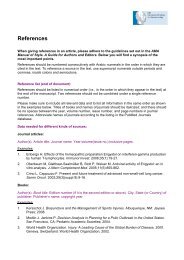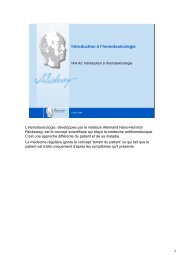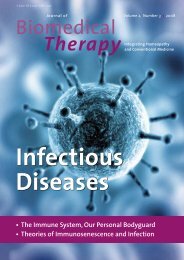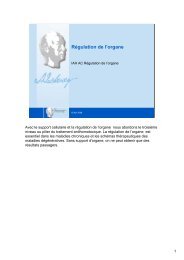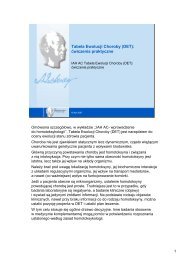Types of Homotoxins
Types of Homotoxins
Types of Homotoxins
Create successful ePaper yourself
Turn your PDF publications into a flip-book with our unique Google optimized e-Paper software.
Chemical poisoning: principal pollutants<br />
• Metals and metalloids...<br />
• Cadmium<br />
• Mercury<br />
• Lead<br />
© IAH 2007<br />
13<br />
Heavy metals are all around in the modern industrial environment.<br />
Cadmium is one <strong>of</strong> the few substances in nature that have absolutely no value to living beings.<br />
Due to bioaccumulation, even in very small concentrations, isolated or in combination with other<br />
substances it is extremely toxic for living organisms and eco systems. Inhaled cadmium gasses<br />
are highly toxic to the kidneys and lungs. Oral intake can damage kidneys and liver severely. A lot<br />
<strong>of</strong> reactions and binding with cadmium are known to be cancer inducing. Cadmium intoxication<br />
can lead to the itai-itai syndrome, Japanese for ‘pain-pain’ disease. Emitted cadmium does end up<br />
in our bodies because it is taken up by plants and in this way comes into the food chain.<br />
Especially our detoxifying organs (kidneys and liver) are damaged by this exogenous homotoxin<br />
and therefore it is double dangerous as intoxication as it makes other toxins less possible to<br />
eliminate them.<br />
Mercury is used in lots <strong>of</strong> modern materials and is even used in dentistry (amalgam dental<br />
fillings). Human activities, like the application <strong>of</strong> agricultural fertilizers and industrial wastewater<br />
disposal, are examples <strong>of</strong> how humans release mercury directly into the soil or water. The<br />
mercury that is released in the environment ends up in surface water or soils eventually. When the<br />
pH values in acidic surface waters are between five and seven, the mercury concentrations in the<br />
water will increase. This is due to the mobilization <strong>of</strong> mercury in the ground near a water source.<br />
Microorganisms are able to convert the mercury that reaches the surface water to methyl mercury<br />
and most organisms absorb this substance quickly. Methyl mercury is also known to cause nerve<br />
damage. Fish are among the organisms that absorb methyl mercury in great amounts from water.<br />
As a consequence, methyl mercury accumulates in fish and passes into the food chain. The<br />
deleterious effects <strong>of</strong> mercury consumed by animals that eat fish include reproductive failure,<br />
damage to intestines, stomach disruption, DNA alteration, and kidney damage.<br />
Lead is a poisonous metal that can damage nervous connections (especially in young children)<br />
and cause blood and brain disorders. Long term exposure to lead or its salts (especially soluble<br />
salts or the strong oxidant PbO2) can cause nephropathy, and colic-like abdominal pains. The<br />
historical use <strong>of</strong> lead acetate (also known as sugar <strong>of</strong> lead) by the Roman Empire as a sweetener<br />
for wine is considered by some to be the cause <strong>of</strong> the dementia which affected many <strong>of</strong> the<br />
Roman Emperors. At one point in time, some lead compounds, because <strong>of</strong> their sweetness, were<br />
used by candy makers. Although this has been banned in industrialized nations, there was a 2004<br />
scandal involving lead-laced Mexican candy being eaten by children in California<br />
13



